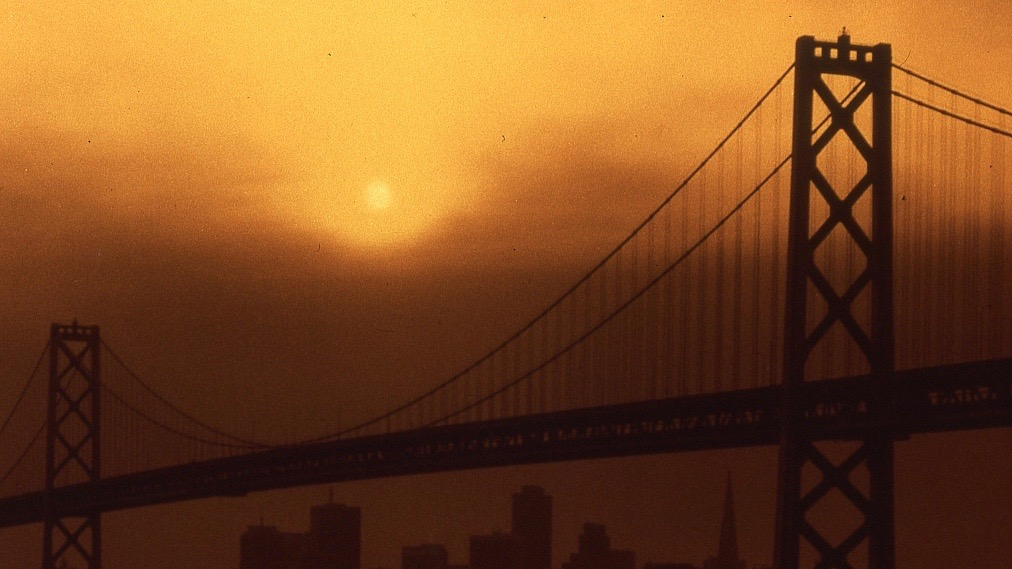
San Francisco Bay Bridge at dusk. (Photo: VCG)
Driving on the Interstate 580 from San Francisco to the Yosemite National Park is like riding a roller coaster from prosperity to austerity. Just across a bay bridge is a tale of two cities. On the one end is the affluent Golden Gate metropolitan area, while on the other is the humble Oakland, far from a final destination of tourists to the area. On the way to the park also sits Sacramento – the forgotten capital of California that stayed out of the limelight until an Oscar-nominated hit “Lady Bird” chronicled its modesty.
The overwhelming divide in three adjacent cities in a state boasting the highest GDP in the US is largely attributed to the legendary Silicon Valley – located in the south of the San Francisco Bay Area. The valley built on chips, however, is losing its shine.
In a recent survey by KPMG, some 60 percent of over 740 technology leaders globally polled believe that the tech innovation center of the world will move away from Silicon Valley within the next four years. New York sits at the top of the list containing 15 alternatives predicted to surpass Silicon Valley.
A gentrified Silicon Valley is losing vitality.
KPMG Global and US Technology Leader Tim Zanni cited several reasons for Silicon Valley losing the tech crown in the coming years, “ranging from the cost-of-living to an overmatched infrastructure to questions about corporate culture.”
The half-a-century tech revolution has caused the bay area to flourish, as California itself beat the United Kingdom to become the world's fifth largest economy last year. In its latest fiscal year, Apple has yielded annual revenue more than five times that of Wyoming. Google, YouTube, Facebook and more successful Internet magnates ballooned the wealthy tech class and attracted the cream of the cream.
But every coin has two sides. High costs of living, especially the expensive housing markets – one of the most prohibitive in the country, is driving both blue collars and the middle class to escape. Some 46 percent of Bay Area residents voted to move out of the region in a 2018 poll released by the Bay Area Council.
San Francisco's cousin Oakland, long dismissed as a dangerous ghetto, also saw an absurd rise in housing prices, as new start-ups decamped there given unaffordable rents in Silicon Valley. It has now edged to be America's third most competitive housing market, though the city still denies gentrification and elitism from across the bridge.
Meanwhile, California is blighted by a skyrocketing homeless population. As many as 134,000 people live on the street, in a shelter or on a bench on any given night, according to the US Department of Housing and Urban Development. Moreover, many are living on the edge of homelessness. That picture presents a dire contrast with the rich, pretty people living an over-the-top life shown in “Big Little Lies,” set in the gentrifying communities in Monterey.
Disparity growing along with the boom seems to shape a quintessential prosperity paradox. Nine in 10 workers in the region saw their real wages drop lower than they did in 1997, with the middle class the most hit with a 14-percent fall in their earnings. Only the top 10 percent are getting richer – those are the top-notch tech geeks who piggyback on Silicon Valley cachet. They despise normal working people and flaunt grueling working formulas as the reason for their success.
Will New Yorkers take up the relay?
Though Silicon Valley cannot be duplicated in the eyes of many, that the world's innovation hub will move away is becoming the reality. Startups are escaping for New York, Boston, Austin and even Canada due to high living costs and an unhealthy corporate culture. For example, T-shirts printed with “9 to 5 for the weak” are quite popular in Silicon Valley. Behemoths are also looking to set up their second headquarters elsewhere. A lack of traditional industries is cited as one of the reasons.
New York, a city of vogue, diversity and sophistication, was poised to become the next Silicon Valley nine years ago, as it is now in the latest poll. Pundits have high expectations for the Big Apple, citing its metropolitan economy, diverse culture and human capital, as well as an accommodating business environment. A mix of traditional industries and hi-tech arenas gave it a boost in the fourth industrial revolution.
But it seems that New York is reluctant to accept the olive branch to become the gleaming, wealthy tech center.
In February, Amazon scrapped the plan for building a new headquarters on New York's Long Island only three months after the announcement. Queens is the largest of the five boroughs of New York City, and what's more, the most ethnically diverse urban area in the world. Home to immigrants, it boasts more languages than anywhere else. For its residents, diversity is instrumental to harmony.
Over the past months, local New Yorkers had been protesting Amazon despite its promise to create at least 25,000 jobs and an average annual salary of 150,000 US dollars for each employee. Queens dwellers, with a long-time anti-gentrification tradition, appeared indifferent to the world's most valuable company and its sweet deal.
Take Seattle – Amazon's hometown – for instance. Rents there surged by some 30 percent and housing prices by over 70 percent over the past five years given the “Amazon effect.” By the way, Amazon also scaled back its plan to expand in Seattle days ago.
Back in New York, freedom and diversity constitute its very spirit. New Yorkers would hardly allow elite tech firms to inject gentrification into their life and culture, though the phenomenon has transformed some of its older neighborhoods and areas such as Brooklyn.
While Silicon Valley will never return to the Valley of Heart's Delight, it's hopeful that New York will remain the Big Apple in the heart of locals and the diverse communities from around the world.


